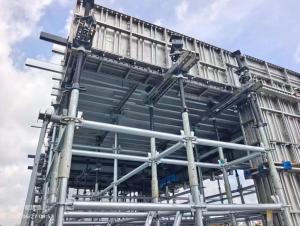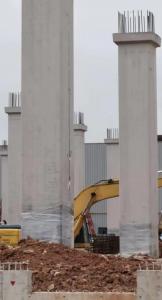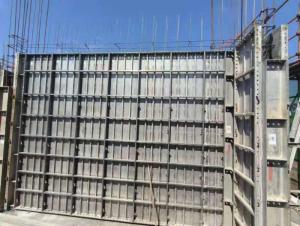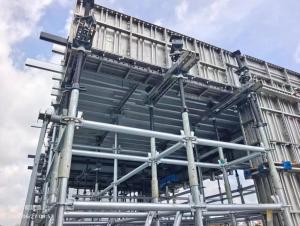High quality steel formwork system,concrete formwork, Stainless Steel Formwork
- Loading Port:
- Shanghai
- Payment Terms:
- TT or LC
- Min Order Qty:
- 1 set
- Supply Capability:
- 1000000 set/month
OKorder Service Pledge
OKorder Financial Service
You Might Also Like
Stainless steel formwork
Replaceable size aluminum formwork :400X1200mm , 400X1500mm
Advantages:
1 Stainless steel formwork, 100% follow the design of aluminum alloy formwork system, it is interchangeable, compatible and can be used together with aluminum formwork at the same time .
2 (The maintenance of the floor or wall is simple and convenient, clean and smooth, easy to remove the mold, and the surface is beautiful.)
Integrated with the thermal insulation structure, the construction will be finished is fast, the efficiency is improved, no release agent is required, the wall has good flatness after de-moulding, no leveling is required, labor cost and time are saved . The construction speed of 5-6 floors a month shortens the construction period and saves Various expenses of the construction general contractor
3Long service life, many turnover times, high recycling value
The number of turnovers is large, especially the characteristics of no dust, no need to brush or less mold release agent, and the characteristics of low renovation costs will bring unlimited optimistic prospects to it.
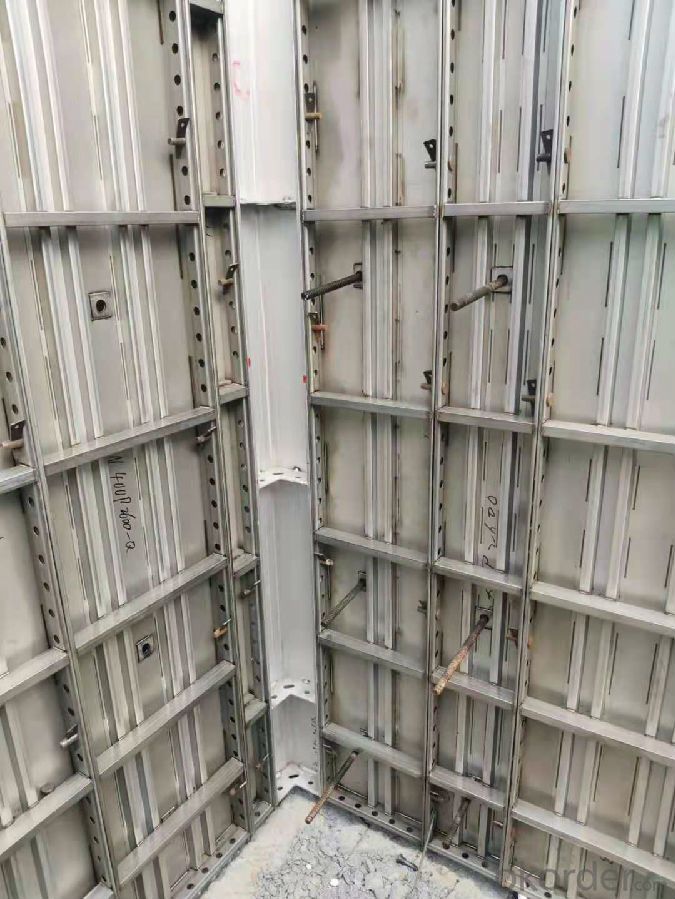


- Q:Can steel formwork be used for hotel construction projects?
- Yes, steel formwork can be used for hotel construction projects. Steel formwork is a versatile and durable solution for constructing concrete structures, including hotels. It offers several advantages such as high strength, durability, and reusability. Steel formwork is capable of withstanding the pressure exerted by wet concrete and can be easily assembled and dismantled, making it suitable for use in various construction projects, including hotels. Additionally, steel formwork provides a smooth and accurate finish to concrete structures, ensuring high-quality construction.
- Q:Can steel formwork be used for bridge piers?
- Yes, steel formwork can be used for bridge piers. It offers high strength, durability, and flexibility, making it suitable for constructing bridge piers that require a sturdy and reliable structure. Additionally, steel formwork allows for easy customization and reusability, making it a cost-effective and efficient choice for bridge pier construction.
- Q:How does steel formwork handle different concrete slump values?
- Steel formwork is a versatile and robust solution that effectively manages different concrete slump values. Slump refers to the consistency or fluidity of concrete and is measured by its workability. Due to its inherent strength and durability, steel formwork is designed to accommodate various slump values. First and foremost, steel formwork offers exceptional support and stability to the concrete during pouring and curing. It can withstand the pressure exerted by wet concrete, regardless of its slump value. The rigid structure of steel formwork ensures that it maintains its shape and integrity, even when dealing with high slump concrete. Furthermore, steel formwork provides flexibility in adjusting the formwork panels to suit different slump values. The panels can be easily adjusted or repositioned to create the desired shape or size for the concrete structure. This adaptability allows steel formwork to efficiently accommodate varying slump values without compromising the quality or integrity of the final concrete product. Additionally, steel formwork provides a smooth and even surface finish for the concrete, irrespective of its slump value. The steel panels are precisely manufactured to ensure a consistent and uniform surface finish, enhancing the overall aesthetics of the concrete structure. This is particularly important when dealing with different slump values as it ensures a visually appealing and professional end result. In conclusion, steel formwork is well-equipped to handle different concrete slump values due to its strength, durability, and flexibility. It provides excellent support, stability, and adaptability during the pouring and curing process, resulting in a high-quality finished product. Whether the concrete has a low or high slump value, steel formwork consistently delivers a smooth and visually appealing surface finish, making it a reliable choice for various construction projects.
- Q:What are the different types of formwork anchors used in steel formwork?
- There are several types of formwork anchors commonly used in steel formwork, including wedge anchors, sleeve anchors, and through-bolt anchors. Wedge anchors are inserted into pre-drilled holes in the steel formwork and are tightened with a wrench to secure the formwork in place. Sleeve anchors are similar to wedge anchors but have a sleeve that expands against the sides of the hole to provide additional stability. Through-bolt anchors consist of a threaded rod that passes through the formwork and is secured with a nut on the opposite side. These anchors offer a strong and reliable connection for steel formwork.
- Q:Can steel formwork be used for both horizontal and vertical construction elements?
- Yes, steel formwork can be used for both horizontal and vertical construction elements. Steel formwork is versatile and can be easily adapted to different shapes and sizes, making it suitable for various construction applications.
- Q:How does steel formwork contribute to the overall speed of construction?
- Steel formwork contributes to the overall speed of construction by providing a durable and reusable solution for creating concrete structures. The use of steel formwork allows for faster and more efficient construction processes as it can be easily assembled and disassembled, reducing the time required for formwork installation and removal. Additionally, steel formwork provides a smooth and consistent surface, resulting in faster curing times and improved productivity.
- Q:What are the different types of tie systems used in steel formwork?
- In construction projects, various tie systems are commonly employed in steel formwork to ensure stability and support during the concrete pouring process. The primary types of tie systems utilized in steel formwork are as follows: 1. Tie rods and wing nuts: This tie system is extensively used in steel formwork. It involves the insertion of steel rods through the formwork panels, which are then secured using wing nuts. This system allows for convenient and effortless assembly and disassembly of the formwork. 2. Shear connectors: In situations where there is a requirement to transfer shear forces between the formwork and the concrete, shear connectors are employed. These connectors usually consist of steel bars embedded in the concrete and connected to the formwork. 3. Steel form ties: Steel form ties are used to hold the formwork panels together, maintaining the desired shape and alignment during concrete pouring. These ties are typically constructed from steel and are available in various lengths and sizes to cater to diverse formwork requirements. 4. Adjustable formwork systems: Designed to offer flexibility in adjusting the formwork to different shapes and sizes, these systems often incorporate adjustable brackets and clamps. They allow for effortless and precise alignment of the formwork panels. 5. Stay-in-place formwork systems: Stay-in-place formwork systems are specifically designed to remain in place even after the concrete has cured, eliminating the need for formwork removal. These systems find application in scenarios where the formwork is intended to become a permanent part of the structure, such as in bridges or tunnels. Overall, the selection of a tie system in steel formwork depends on factors such as project requirements, structural design, and specific construction site conditions. It is crucial to choose a tie system that can provide the required stability and support for the formwork, while also considering factors such as ease of installation, reusability, and cost-effectiveness.
- Q:How does steel formwork handle formwork stability during concrete pouring?
- Steel formwork provides excellent formwork stability during concrete pouring due to its high strength and rigidity. It can withstand the pressure and weight of the fresh concrete without deformation or collapse, ensuring the desired shape and structure of the concrete elements. Additionally, steel formwork can be easily adjusted and secured in place, allowing for precise alignment and stability during the pouring process.
- Q:Can steel formwork be used for both single-sided and double-sided forming?
- Yes, steel formwork can be used for both single-sided and double-sided forming. It is a versatile and durable material that can withstand the pressure and weight of concrete on both sides, making it suitable for various construction applications.
- Q:Does steel formwork require any special expertise or training for installation?
- Yes, steel formwork does require special expertise and training for installation. Steel formwork is a complex system of interlocking panels and components that are used to create temporary molds for pouring concrete structures. It requires a thorough understanding of the formwork design, installation techniques, and safety procedures. Professionals who work with steel formwork need to be knowledgeable about the specific requirements of each project, including the load-bearing capacity, formwork connections, and the proper placement of reinforcement. They also need to have the skills to accurately measure and cut the steel panels, assemble them correctly, and ensure that the formwork is properly aligned and braced. In addition, expertise in steel formwork installation includes understanding the different types of formwork systems available, such as adjustable steel formwork, modular steel formwork, or tunnel formwork, and knowing how to select the most appropriate system for a particular project. This knowledge is crucial to ensure that the formwork can withstand the pressure exerted by the wet concrete and can produce a structurally sound and aesthetically pleasing final result. Furthermore, proper training in steel formwork installation is essential to ensure the safety of workers and the overall success of the construction project. This includes knowledge of safety regulations, understanding how to use personal protective equipment, and being aware of potential hazards and how to mitigate them. Overall, due to the complexity and specific requirements of steel formwork installation, it is important to have professionals with the necessary expertise and training to ensure a smooth and successful construction process.
1. Manufacturer Overview |
|
|---|---|
| Location | |
| Year Established | |
| Annual Output Value | |
| Main Markets | |
| Company Certifications | |
2. Manufacturer Certificates |
|
|---|---|
| a) Certification Name | |
| Range | |
| Reference | |
| Validity Period | |
3. Manufacturer Capability |
|
|---|---|
| a)Trade Capacity | |
| Nearest Port | |
| Export Percentage | |
| No.of Employees in Trade Department | |
| Language Spoken: | |
| b)Factory Information | |
| Factory Size: | |
| No. of Production Lines | |
| Contract Manufacturing | |
| Product Price Range | |
Send your message to us
High quality steel formwork system,concrete formwork, Stainless Steel Formwork
- Loading Port:
- Shanghai
- Payment Terms:
- TT or LC
- Min Order Qty:
- 1 set
- Supply Capability:
- 1000000 set/month
OKorder Service Pledge
OKorder Financial Service
Similar products
New products
Hot products
